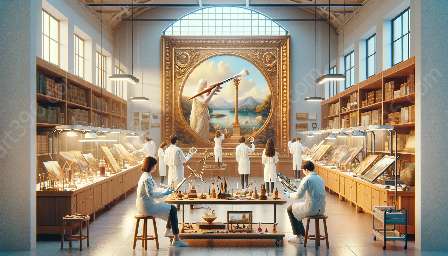Introduction
Art conservation is a delicate and intricate process that aims to preserve and restore valuable artworks for future generations. With the advancement of digital tools, virtual restoration has become an essential component in the study and conservation of art history. This article explores the role of virtual restoration in art history and its compatibility with digital tools in art conservation.
Understanding Virtual Restoration
Virtual restoration is the practice of digitally reconstructing and restoring artworks using advanced imaging technologies and computer software. It allows conservators and art historians to visualize and analyze artworks in ways that were previously impossible, offering valuable insights into their original form and condition. By creating virtual replicas, conservators can experiment with different restoration techniques without altering the original artwork, making it a crucial tool in art conservation.
Preservation of Art History
Virtual restoration plays a significant role in the preservation of art history by providing a non-invasive method for studying and documenting artworks. Through high-resolution digital imaging and 3D modeling, conservators can capture the intricate details of artworks, including surface textures, brushstrokes, and color gradients. This detailed documentation serves as a valuable resource for future research and conservation efforts, ensuring that the knowledge and history of artworks are preserved for generations to come.
Compatibility with Digital Tools
Virtual restoration aligns with the broader use of digital tools in art conservation, as it leverages advanced technologies to enhance the understanding and preservation of artworks. Digital tools such as infrared reflectography, X-ray fluorescence, and multispectral imaging complement virtual restoration by providing additional data on the materials and techniques used by artists. These combined digital approaches offer a comprehensive view of artworks, enabling conservators to make informed decisions about conservation treatments and ensure the long-term stability of the pieces.
Challenges and Limitations
While virtual restoration has revolutionized the field of art conservation, it is not without its challenges and limitations. One of the primary concerns is the potential for misinterpretation or misrepresentation of the original artwork due to the subjective nature of digital reconstruction. Conservators must exercise caution and rely on multidisciplinary collaboration to validate the accuracy of virtual restorations and interpretations. Additionally, the accessibility and cost of advanced digital tools may pose barriers to widespread adoption, highlighting the need for continued research and development in this field.
Conclusion
Virtual restoration has emerged as a powerful tool in the study and conservation of art history, offering innovative ways to explore and preserve valuable artworks. Its compatibility with digital tools in art conservation enables a comprehensive approach to understanding and safeguarding cultural heritage. By embracing virtual restoration and digital technologies, the field of art conservation continues to evolve, ensuring the longevity and appreciation of artworks for future generations.

